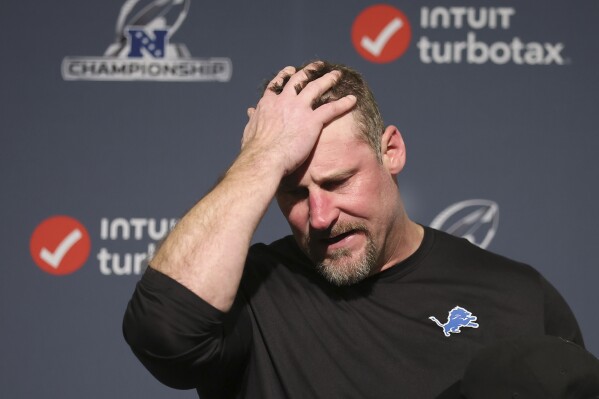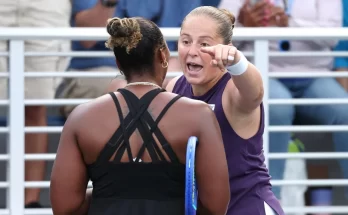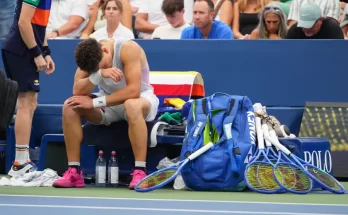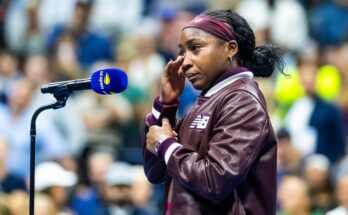Motor City Gut Punch: Lions Stumble Out of the Gate as Dan Campbell Loses Amon-Ra St. Brown for Opening Stretch—Can Detroit’s Grit Culture Survive a Star WR Sidelined?
The Detroit Lions spent the entire offseason bathing in something rarely afforded to a franchise that once specialized in heartbreak: national belief. After a breakthrough campaign that rewired how the league talks about football in the Motor City, Dan Campbell’s crew entered this season carrying expectations they used to watch happen to other teams—double-digit win projections, prime-time slots, “Super Bowl sleeper” panels, even a wave of fantasy drafts built around the idea that Detroit’s offense had become one of the league’s safest weekly bets. And then the calendar turned, the pads cracked, and reality snapped teeth. A rough early start—red-zone freezes, protection hiccups, defensive leaks that Campbell thought had been sealed in camp—was compounded by the kind of personnel blow that tests cultures more than playbooks: star wide receiver Amon-Ra St. Brown will miss the first few games with a soft-tissue injury, leaving quarterback Jared Goff without his comfort blanket, the route artist who turned third-and-need-it into a Lions trademark. In a division that punishes slow starts and a conference deeper at the top than it has been in years, the margin is already thin; subtracting the sun from Detroit’s passing universe threatens to dim everything the team built last fall.
To appreciate the scale of the problem you have to understand what St. Brown is to Detroit’s offensive structure. He isn’t simply a WR1 who racks up targets; he is the timing metronome, leverage manipulator, and “get us back on schedule” emergency release built into nearly every critical call sheet section from green zone to two-minute drill. When Campbell and offensive coordinator Ben Johnson script openers, St. Brown’s alignment choices force defenses to declare coverage shells early, and when Detroit shifts or trades formation strength, his ability to win inside leverage turns free-access yards into rhythm fuel. Remove him and the dominoes fall fast: spacing compresses, safeties cheat run fits, linebackers sit flatter, and Goff’s eyes hold a beat longer because the trust rep that has been there for three seasons suddenly isn’t flashing open on time. You can scheme around a missing vertical specialist or use committee targets to replace a boundary matchup guy; replacing a volume precision slot who also blocks like a tight end is harder.
The opening weeks exposed that challenge in full glare. Drives that last year lived on slants, option routes, pivot-outs, and jet-motion counters built off St. Brown’s gravity now look labored. Young receivers are running the right routes but not winning the leverage nuance that turns “open-ish” into “throw now.” Goff has always been a rhythm passer who can shred coverage when protected and confident, but his historical dips arrive when progressions stretch and internal clocks speed up. That’s what rough starts look like: hurries that don’t go down as sacks but wreck down-and-distance, checkdowns short of the marker, drives that end in field goals instead of touchdowns. Campbell’s whole ethos—bite kneecaps, stack physicality, win the fourth quarter—needs early drive production to feed energy loops. Without it, the emotional fuel that defines Ford Field begins burning too hot or too thin.
Campbell addressed the injury with the straight-ahead toughness that has made him a cult figure: next man up, no excuses, we built this roster for adversity. But he’s also a realist. You could see it in his explanation of snap distribution: Detroit won’t simply plug in a depth-chart clone; they’ll alter game plans week to week, chase matchups, and lean heavier on tight ends and backs in the passing game until St. Brown returns. Expect heavier 12 personnel groupings to force base looks, freeing Detroit’s run-action shot game. Expect manufactured touches—quick motion swings, tunnel screens—to get the ball out fast and rebuild Goff’s confidence rhythm. Expect more vertical clear-outs from Jameson Williams (whose speed changes coverage math whether or not the deep ball hits) to open intermediate grass for Sam LaPorta and the running backs on angle routes. That’s the blueprint: redistribute function, not just targets.
Still, losing your tone-setting receiver changes how defenses attack. Opponents already shifted to more man-match principles against Detroit, trusting they could disrupt timing without paying St. Brown’s option-route tax; now they’ll press more aggressively at the line and spin late safeties to bait throws outside the numbers. Campbell’s staff will counter with stacks and bunch releases to free young receivers, but the trust chemistry required to hit those windows under live fire takes reps. The first two opponents on Detroit’s slate—both built to heat quarterbacks and tackle in space—punished every hesitation. That’s how “rough start” becomes a headline: not because Detroit forgot how to play, but because elite-level football turns tiny sync errors into stalled possessions.
The injury also stress-tests Detroit’s depth philosophy. Campbell and GM Brad Holmes have drafted and developed with an eye toward redundancy at identity positions: offensive line, running back versatility, hybrid tight ends, downhill linebackers who can bend but not break. Wide receiver depth was upgraded, but much of it is developmental—traits prospects still learning full-route trees, special teams glue guys, role separators. This stretch will accelerate their growth. Can Donovan Peoples-Jones, the veteran acquisition with size and contested-catch chops, become a short-window trust target? Can Kalif Raymond scale volume beyond gadget and return packages? Can Williams channel top‑end speed into route discipline that forces bracket coverage even when targeted sparingly? If even two of those questions tilt positive, Detroit can float. If not, the offense becomes predictable and Campbell’s beloved balance snaps.
There’s a psychological layer here, too. Detroit’s renaissance under Campbell has been powered by an “us vs. everyone who laughed” emotional engine, but success alters motivational chemistry. Once national belief arrives, the chip dulls. Early adversity re-sharpens it—but only if the locker room channels frustration into clean, physical execution, not hero ball. St. Brown is a culture connective; he practices the way Campbell preaches. Younger players seeing him sidelined will either elevate their own detail or drift. Campbell’s answer was to crank accountability: practice periods with heightened competition metrics, film sessions where route depth is graded like gap fits on defense, and a public recommitment to complementary football so the defense knows it must buy the offense time.
Speaking of that defense: part of navigating a star offensive injury is changing the way you win games. Detroit’s front, led by Aidan Hutchinson, now carries extra burden to tilt field position and manufacture short fields. Strip-sacks, tipped balls, run-stuffing penetration on early downs—all of it shortens the distance Goff has to cover without his primary separator. Special teams, already a Campbell obsession, become leverage plays: hidden yards in punt coverage, aggressive but calculated fourth-down decisions, field-goal trust when drives stall. Good teams survive star absences by tightening the bolts everywhere else. That’s Detroit’s path through September.
If you’re looking for silver linings, there are a few. First, St. Brown’s injury timeline—“first few games” rather than half-season loss—means Detroit’s goals remain intact if it can hover near .500 while he rehabs. Second, forced distribution can accelerate the breakout of LaPorta and Jahmyr Gibbs as volume receivers, diversifying the offense long-term. Third, adversity now forces installation of contingency packages the team might need again in December. Creative problem-solving is a muscle; flex it early and it grows.
History says the NFL punishes teams that sag in September, but it also says identity outfits with stable coaching and locker-room buy-in can weather turbulence others cannot. The Lions have already done hard culture work—digging out from decades of frustration, convincing veterans to stay, building schemes players believe in. That foundation doesn’t evaporate because a star misses 2–3 games. It does, however, demand action: crisper third-down play-calling, earlier scripted rhythm throws, heavy run-commitment even when box counts say pass, and defensive urgency that refuses to let deficits balloon. Campbell preached “grit” when the roster was thin; now he must operationalize it with expectations on the line.
The national narrative will swing wildly week to week—“Are the Lions overrated?” on Monday morning shows if the offense sputters; “Classic Campbell toughness” if Detroit grinds out a win behind defense and special teams. Inside the building the mission stays flat: survive the stretch, reinsert St. Brown when healthy, and reaccelerate toward the midseason gauntlet with playoff math still glowing green. Locker rooms respond to clarity, and Campbell has always delivered that plainly.
When Amon-Ra St. Brown returns—and the Lions remain adamant this is a short-term absence—the offense will re-expand. Defenses that got comfortable rolling late help to Williams or cheating gaps against Detroit’s inside zone will rediscover the misery of defending a receiver who wins leverage before contact and punishes off coverage. The hope in Detroit is that when that day comes, the young receivers now forced into grown-man reps will have shed developmental hesitation, giving the Lions a more layered attack than the one that lit up the league a season ago. Sometimes losing a star temporarily reveals how much more you can build around him.
For now, though, the Motor City is in grind mode. Rough starts test hype; injuries test belief. Dan Campbell has built a program that swears it won’t flinch when punched. The schedule just threw the first. September will show whether Detroit absorbs the shot, swings back, and keeps marching—or whether the absence of the guy who makes their offense hum exposes a fragile core under all that grit. Betting against Campbell has not aged well lately. But even the toughest teams need chain-movers, and nobody in Honolulu blue moves chains like Amon-Ra St. Brown. Hurry back, Sun God. Detroit’s sky got cloudy fast.



